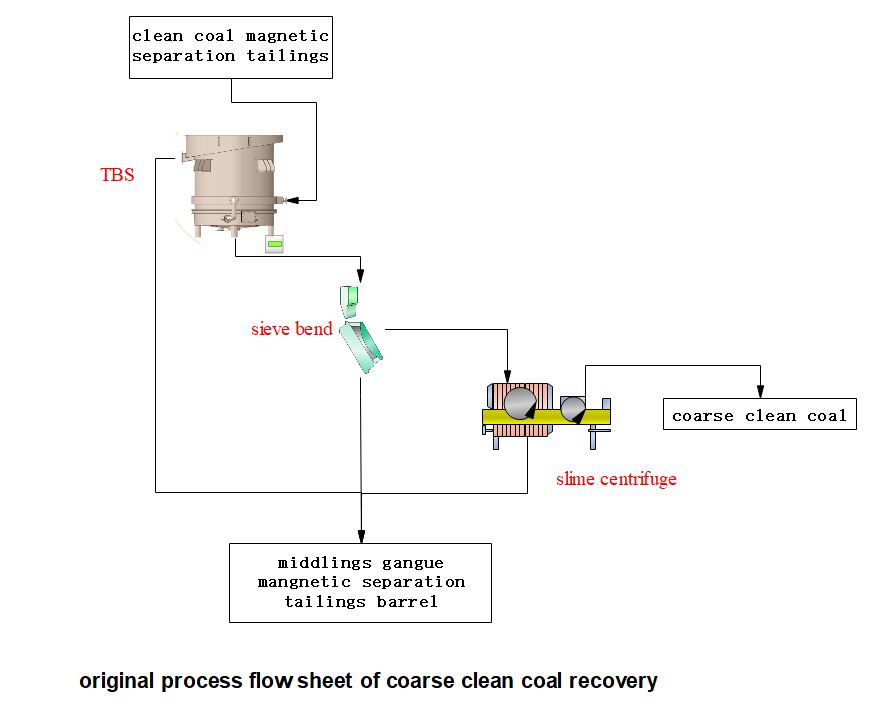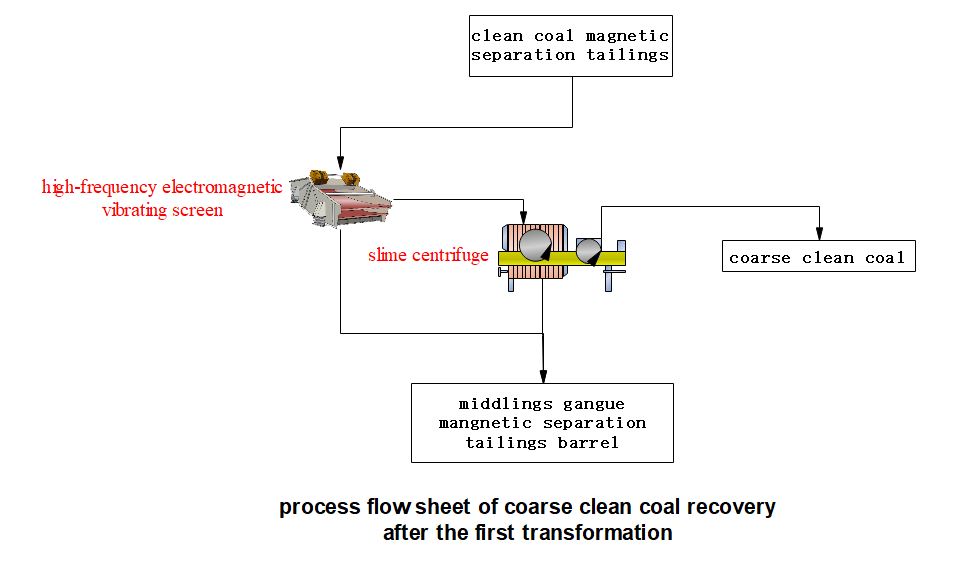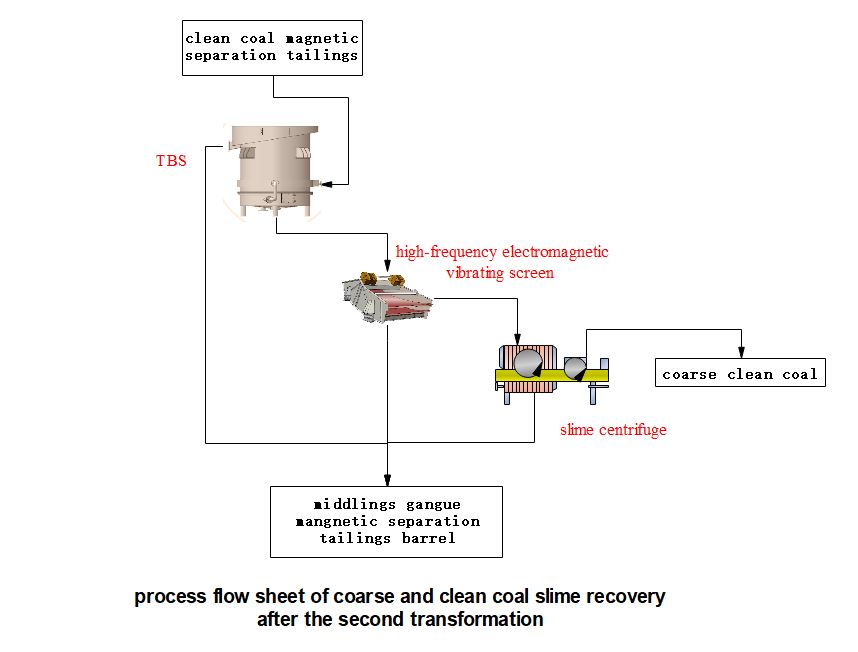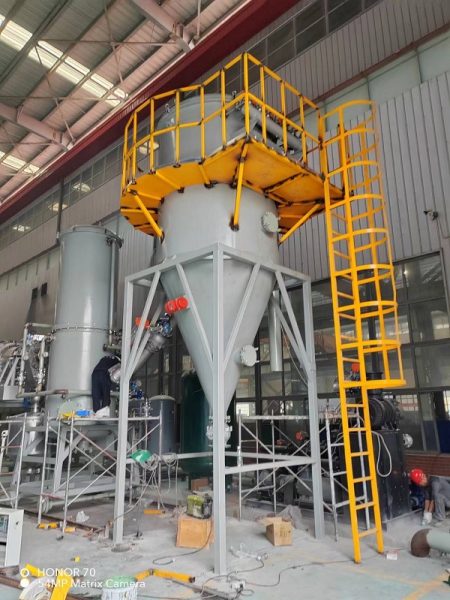
Company:Chengdu Cobalt Mining Co., Ltd
Email: sales@hot-mining.com
Phone:+86 28 83311885
Fax:+86 10 58646590
Address:Room10811, Floor8, Building A, Galaxy SOHO, Dongcheng Dist, Beijing, P.R.China
The Application of T-TBS + High-frequency Electromagnetic Vibrating Screen Coarse Slime Recovery Technology in a Coal Preparation Plant
A coal preparation plant is a mine type coal preparation plant mainly for gas and fat coal, with a design capacity of 0.9 MU/a. The main workshop production process of the coal preparation plant is as follows:
(1)The 50-0 mm size raw coal is separated from the clean coal, middings and gangue by the three product dense medium hydrocyclone without pressure feeding, and then it is the final product after the demineralization and dehydration.
(2) The qualified medium of the clean coal sieve bend is separated by the shunt box, one part is mixed with the qualified medium under the clean coal, middings and gangue demineralization screen and returned to the qualified medium barrel; the other part is mixed with the thin medium under the clean coal demineralization screen and fed into the fine coal magnetic separator; The concentrate of magnetic separation is put into the qualified medium barrel, the tailings of magnetic separation and the centrifugal liquid of clean coal are concentrated and classified by the clean coal hydrocyclone group, the underflow is put into the T-TBS, the overflow of T-TBS is then dehydrated by the sieve bend and the coal mud centrifuge, and then mixed with the main clean coal.
(3) The medium of middings demineralization screen and the medium of gangue demineralization screen enter into the middings and gangue magnetic separator, the concentrate of magnetic separation enters into the qualified medium barrel, the water from the sieve bend of tailings and coarse and fine coal slime, the underflow of T-TBS, the centrifugal liquid of coarse and fine coal slime centrifuge and the centrifugal liquid of middings -- It starts from the middings and gangue hydrocyclone group, and after concentration, it enters the middings and gangue slime into the high-frequency screen of the middings and gangue slime, and the middings centrifuge is dehydrated and then mixed with the washing coal.
(4)Clean coal hydrocyclone group overflow, middings and gangue hydrocyclone group overflow, middle coal and gangue slime sieve bend water, middle coal and gangue slime high-frequency screen water into the thickener for concentration.
(5) After the slime water is concentrated by the thickener, the overflow is used as the circulating water, and the underflow is recovered by the filter press.
Problems in Design of Recovery Process of Coarse and Clean Coal Slime
T-TBS + sieve bend + slime centrifuge process is adopted in the process design of coarse and clean slime recovery, as shown in Figure 1. In the actual production process, due to the serious water running off of the sieve bend, the materials entering the slime centrifuge do not meet the concentration requirements of the equipment and human materials, and the dewatering effect of the Slime Centrifuge is poor, resulting in the crude and refined slime products fail to meet the required indicators, which directly affects the quality of the refined coal products. For this reason, a coal preparation plant has carried out the first transformation of the coarse slime recovery system according to the actual situation of the site.

The First Transformation of Coarse and Clean Slime Recovery System
Process Flow of The First Transformation
Considering the actual particle size of equipment separation and the actual production situation on site, a coal preparation plant introduced two sets of high-frequency electromagnetic vibrating screens to replace the original T-TBS Interference Bed Separator and sieve bend. The process flow is shown in Figure 2.

First Transformation Effect
At the initial stage of transformation, the raw coal quality of the candidate is relatively stable, and the coarse and fine slime recovered is better. Table 1 shows the particle size composition of the modified coarse and clean coal slime, from which it can be seen that 0.15-0.075 mm particles and less than 0.075 mm particles account for 8.62% and 1.42% of the whole grade respectively.

Problems After the first transformation
After the process transformation of coal preparation plant for a period of time, the underground mining face of a coal mine passes through the fault, the coal quality changes greatly, there are more fine particles of gangue, the composite screen of high-frequency electromagnetic vibration screen is easy to be blocked, resulting in more high ash fine particles remaining, which seriously affects the ash content of coarse and fine coal slime. After the research of relevant personnel, it is decided to carry out the second transformation of the coarse slime system.
The Second Transformation of Coarse and Clean Slime Recovery System
With the experience of the first transformation, according to the advantages of T-TBS by density and high-frequency electromagnetic vibrating screen by particle size. The original T-TBS was put into use again. The low ash Slime (overflow) from the T-TBS was put into the high-frequency electromagnetic vibrating screen for separation and finally into the Slime Centrifuge for dehydration. The process flow is shown in Figure 3.

See Table 2 for the screening test results of coarse and clean coal slime after the second transformation.

It can be seen from the table that the ash content of coarse and clean coal slime is stable at about 9%, and the content of fine coal slime smaller than 0.15 mm is less than 2%, indicating that the quality of coarse and clean coal slime has been very stable.
Conclusion
Due to the relatively small amount of slime in the raw coal of a coal preparation plant, the use of pre desliming has little impact on the separation effect of the hydrocyclone, so the pre desliming link is omitted, and the use of full-level human washing saves both manpower and material resources. Most of the coarse slime with low ash content can be recovered after the slime recovered by the magnetic separator and sorted by the T-TBS. The high ash fine particles mixed in the coarse slime can be treated by the high-frequency electromagnetic vibration screen to obtain the qualified coarse and fine slime. Compared with sieve bend, the effect of high frequency electromagnetic vibration screen is better, and the product index of coarse and clean coal slime is more stable. For the separation of coarse slime, the T-TBS Interference Bed Separator in the density separation equipment has a great advantage; the high frequency electromagnetic vibrating screen in the particle size separation equipment has a good separation effect. The production practice of a coal preparation plant shows that the technology of coarse and clean slime recovery of T-TBS + high-frequency electromagnetic vibration screen + slime centrifuge dewatering is reasonable, which is suitable for the coal preparation plant with relatively less slime and unstable coal quality.
If you're interested in the T-TBS Interference Bed Separator, pls just contact us:
Liv Wang
Tari Wang
Peter Gao
E-mail
liv.wang@hot-mining.com
tari.wang@hot-mining.com
peter.gao@hot-mining.com
Tel
+86 18227011092
+86 15927439651
+86 13436553365
|
|
Liv Wang |
Tari Wang |
Peter Gao |
|
|
liv.wang@hot-mining.com |
tari.wang@hot-mining.com |
peter.gao@hot-mining.com |
|
Tel |
+86 18227011092 |
+86 15927439651 |
+86 13436553365 |
|
|
|
|
|
|
|
|
|
|
|
|
Please feel free to give your inquiry in the form below.We will reply you in 24 hours.























